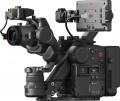In box
—
Phone mount(like a screen). The ability to use your smartphone as your stabiliser screen. The device's camera is not used in this case: filming is carried out either on the built-in camera of the stabiliser or on the action camera attached to it. Note that the smartphone can be used not only as a viewfinder but also to control the camera; specific features depend on the stabiliser model.
—
Focus control mechanism. A device that allows the stabiliser controls to focus the lens on the installed camera. It simplifies the use of manual focus lenses greatly.
—
Two-handed handle. The two-handed handle increases agility, stability and precision.
—
Quick release plate. This element makes it possible to quickly install and remove the camera from the stabiliser without using third-party tools.
—
Tripod. The presence of a small tripod in the stabiliser kit — a tripod, which allows you to use the device in a stationary position, setting it on a flat hard surface. Usually the tripod is detachable.
—
Remote control. The presence in the kit of a small remote control. It is convenient when the device is installed at a remote distance, for example, in a car.
—
Bag / Case. The pre
...sence of a bag or case in the standard package of the stabilizer. Bags often come with handles or a strap for convenient carrying, while cases are somewhat simpler — they don't have handles and are designed to be carried in a travel bag, backpack, etc. A bag or case protects the device from dust and other contaminants and to some extent shields the contents from damage in case of bumps or falls. Additionally, bags or cases can often be used to store extra accessories.Max. load
The maximum weight that the stabiliser is designed to carry.
This is the maximum weight of the camera with all accessories allowed for this model.
Rotation angle
The range of rotation angles supported by the steadicam.
In this case, it means turning the camera to the right or left, without tilting back and forth.
Tilt angle
The range of forward-backwards tilt angles relative to the vertical position supported by the stabiliser.
It can be written in different ways.
The simplest option is when one angle value is indicated in the characteristics. This may mean that the camera can deviate from the neutral position in both directions by the same angle, which is half the range.
Another option is used when the angles of tilt forward and backward are not the same. In such cases, the horizontal position of the camera on a vertical steadicam is taken as zero, the “-” sign indicates the maximum angle of camera deflection back, lens up, and the “+” sign — forward, lens down.
Bank angle
The range of roll angles (to the side) supported by the stabiliser.
Can be recorded in two ways (See "Tilt angle")
Max. controlled speed
The maximum controlled speed supported by the stabiliser is, in fact, the highest speed of rotation of the camera along one axis or another, provided by the device. This is the maximum rotation speed of the entire structure, at which the stabiliser automation can provide effective stabilisation along the corresponding axis (that is, keep the camera stationary).
This item is directly related to the purpose of the stabiliser — for shooting while hiking or cycling on flat terrain, a high stabilization speed is hardly necessary, but during surfing, acrobatic aerobatics and other similar activities, the “slow” stabiliser often turns out to be ineffective.
Full HD (1080p)
Full HD (1080p) video recording capabilities supported by the stabiliser's camera.
Full HD has a resolution of 1920x1080 pixels. To date, this format is considered to be almost optimal in terms of the ratio between image quality and technical requirements: it noticeably surpasses HD in terms of image detail and, at the same time, does not require such capacious storage drives as 2K and especially 4K standards.
Quad HD
Quad HD (2K) video recording capabilities supported by the stabiliser's bundled camera.
Specifically, the 2K standard includes video formats that have a resolution of more than 1920 pixels horizontally, but do not reach 4K (see the relevant paragraph). 2K stabiliser's cameras usually operate at a resolution of 2704x1520 pixels.
Video file format
File formats in which the built-in stabiliser camera can save recorded video. In brackets, the type of codec used for recording, for example, MP4 (H.264), can be specified.
This parameter is critical if the footage is planned to be viewed on a consumer video player, media centre or other similar device — this device must support the appropriate formats. But if you plan to watch the video on a computer, you can not pay much attention to file formats: modern operating systems have extensive sets of codecs (and the missing ones can be downloaded and installed additionally), so there are usually no problems with playing the main types of video.
